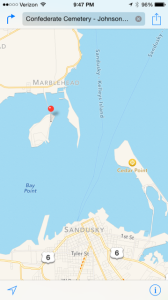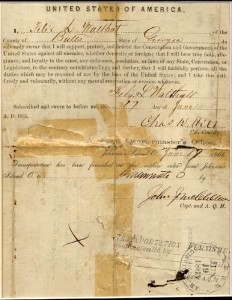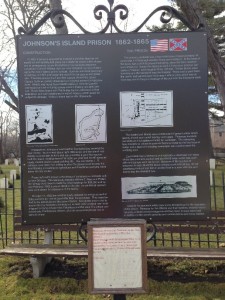So now that Secret Promise is loose in the world, I wanted to share some interesting facts about the time period in which the book is set.
Secret Promise takes place primarily in England in 1867, just after the American Civil War. The book’s hero, Edward Mason, had left England about seven years before, to deliver a ship for his father. Unfortunately, he was thrown off course by weather and circumstance, and instead of returning quickly to his sweetheart, he spends most of the next five years in a Union prison.
We first learn about Edward in my debut novel, Stirring Up the Viscount. Edward is the brother of the heroine in Viscount, which leaves us completely in the dark about his fate. When I wrote it, I hadn’t the foggiest idea what had happened to him. Stranded on a deserted island? Amnesia? Jail? So many choices!
Jail sounded promising, so I did some research about Civil War prisons, and discovered there was actually a prison for Confederate soldiers in northern Ohio, on Lake Erie. Even though I had to take some literary license to do it, I knew I had to put Edward in it.
 Johnson’s Island is a tiny dot of land in Lake Erie, just three miles across the bay from Sandusky (home of Cedar Point Amusement Park, for those of you who love roller coasters!). In order to cut down on traffic on the island, there’s a gate at the start of the causeway that connects the island to Marblehead, and you need to pay $2 to open it. (I know this because I dragged my son there one weekend last March. The photo at left is a screen shot from the Maps app on my phone.)
Johnson’s Island is a tiny dot of land in Lake Erie, just three miles across the bay from Sandusky (home of Cedar Point Amusement Park, for those of you who love roller coasters!). In order to cut down on traffic on the island, there’s a gate at the start of the causeway that connects the island to Marblehead, and you need to pay $2 to open it. (I know this because I dragged my son there one weekend last March. The photo at left is a screen shot from the Maps app on my phone.)
The island was initially called Bull’s Island, after its first owner, E.W. Bull. It was purchased by Leonard B. Johnson in 1852 and renamed. Its 300 acres were inhabited and farmed solely by his family. At the start of the war, the U.S. military toured locations around the Great Lakes for suitable prisoner of war camps. Johnson’s Island was selected—it made a perfect prison, as it was small and easily defended, readily accessible from the mainland by boat, and difficult to escape.
The U.S. government leased the island, built guard barracks, a prisoner stockade, hospital, and other buildings, and sent the first Confederate prisoners there in April of 1862. In the 40 months of the prison’s operation, over 9,000 prisoners were housed on the island. At the start of the war, most prisoners were exchanged for Union prisoners after about five months, and others were released into the Union Army after taking an oath of allegiance to the United States. After Gettysburg, most prisoners were held from 12 to 18 months.
The average number of prisoners held at any one time was 2,000 to  2,500. In January of 1865, however, about 3,200 prisoners were in residence, which was substantially more than capacity. Prisoners slept in narrow bunks, two men per bed.
2,500. In January of 1865, however, about 3,200 prisoners were in residence, which was substantially more than capacity. Prisoners slept in narrow bunks, two men per bed.
 Johnson’s Island wasn’t a particularly harsh place to be imprisoned, other than the weather. (In March when I visited, the wind was bitingly cold as it whipped off Lake Erie, and I was wearing a down coat. I can only imagine how miserable a Confederate soldier must have been in prison garb.) The biggest problem most of the prisoners faced, at least in the early years of the war, was boredom. The men devised ways to entertain themselves, including producing plays, writing letters, journals, and poetry, and conducting rat hunts. Other men amused themselves by trying to escape. In nearly four years, however, only four men succeeded, escaping to Canada in January 1864.
Johnson’s Island wasn’t a particularly harsh place to be imprisoned, other than the weather. (In March when I visited, the wind was bitingly cold as it whipped off Lake Erie, and I was wearing a down coat. I can only imagine how miserable a Confederate soldier must have been in prison garb.) The biggest problem most of the prisoners faced, at least in the early years of the war, was boredom. The men devised ways to entertain themselves, including producing plays, writing letters, journals, and poetry, and conducting rat hunts. Other men amused themselves by trying to escape. In nearly four years, however, only four men succeeded, escaping to Canada in January 1864.
 Other than exchange or transfer, swearing allegiance, or escaping, the only way to leave the prison was death. Approximately 241 men died while confined on Johnson’s Island, most due to illness. The majority of these men are buried in the Confederate Cemetery, which is the only publicly accessible part of the island. I discovered when writing this post that Heidelberg University does archaeological digs on the island, and research suggests that there may be others buried on the island in other locations.
Other than exchange or transfer, swearing allegiance, or escaping, the only way to leave the prison was death. Approximately 241 men died while confined on Johnson’s Island, most due to illness. The majority of these men are buried in the Confederate Cemetery, which is the only publicly accessible part of the island. I discovered when writing this post that Heidelberg University does archaeological digs on the island, and research suggests that there may be others buried on the island in other locations.
The last prisoners left Johnson’s Island in September 1865. The buildings were auctioned off—to Mr. Johnson, who eventually dismantled and sold most of them. Since then there have been many attempts to develop the island, but it was named a National Historic Landmark in 1990, and now serves as an exclusive residential area.
If you’re ever at Cedar Point, take an extra hour and head over to Johnson’s Island. And to learn more about Johnson’s Island and the prison there, check out these sites:
http://johnsonsisland.org/history-pows/civil-war-era/
http://history.rays-place.com/oh/erie/johnsons-island.htm
http://johnsonsisland.heidelberg.edu/
http://www.ohperry341.com/JohnsonsIsland.html
http://deadohio.com/johnsonsisland/ (ghosts!)
https://en.wikipedia.org/wiki/Johnson%27s_Island
